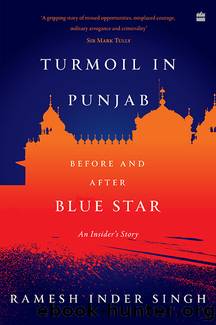Turmoil In Punjab by Ramesh Inder Singh

Author:Ramesh Inder Singh
Language: eng
Format: epub
Tags: null
Publisher: HarperCollins India
Published: 2022-10-15T00:00:00+00:00
27
The Hindu Exodus
ABOUT FIFTY HINDU FAMILIES FROM TARN TARAN VILLAGE MOVED out to Karnal, without the civil administration knowing about itâwe had been caught napping. There had been no intelligence alerts, nor had the grass-roots revenue officials sent any report. It was a collective administrative dereliction. The news of mass migration in the media set alarm bells ringing and I rushed to Haryana to persuade the Hindus to return to their homes in Punjab.
The migration had started from Batala, the industrial town in Gurdaspur district. On 20 February 1986, the terrorists targeted innocent civilians in this town. The situation assumed a communal colour when the supply of essential commodities to the town was stopped, by provoking the people of surrounding villages to lay blockades on all entry points to the city. Nearly thirty shops were damaged or looted and about seven factories were set on fire by the mobs. Curfew was imposed. The administration did succeed in controlling the situation, but the ineffectiveness of the system to protect the innocents got ingrained in the minds of the common man. Faith in the ability of the administration was further eroded when on 24 February, in a daring raid on the armoury of the Government Railway Police at Tarn Taran, terrorists looted sixteen rifles and over 400 cartridges, and escaped.
In Amritsar district, the migration began as a trickle in early 1986, first from the hotbed of terrorism, Fatehabad, and its adjoining villages, and slowly spread to other parts of the district. Suddenly, posters appeared in the villages asking Hindus to leave. In a few cases, prominent Hindus received threat letters. It was a chilling affair. In village after village, the militants would come, usually at midnight, mercilessly slaughter the targeted men and even women and children, fire warning shots in the air, occasionally raise slogans and disappear. They did not even spare the old and the infirm. Our sector scheme under which paramilitary forces were deployed to cover villages with Hindu habitations had not worked. Nor had the liberal grant of arms licences to Hindus or the setting up of village defence committees and thikri pehra, where all able-bodied men and those holding licensed weapons were voluntarily inducted to keep vigil.
It was a well-planned strategy of the ISI to sharpen communal polarization in Punjab. Pakistan-sponsored agents had started working on it in the early 1980s by planting cigarettes in gurdwaras and severed parts of cows in temples, but at that time, passions were modulated by saner elements in both the communities.
However, 1984 provided militants with the opportunity to trigger an exodus from Punjab, when victims of the anti-Sikh violence, after the assassination of Indira Gandhi, started converging from all over India to Punjab. By the second week of November 1984, some 50,000 of them had reached the state. Over 1,814 of them arrived in Amritsar in the first few days of November, hoping for help from the SGPC. They narrated horrendous stories of killings and that added to the prevailing social tension in the city.
Download
This site does not store any files on its server. We only index and link to content provided by other sites. Please contact the content providers to delete copyright contents if any and email us, we'll remove relevant links or contents immediately.
| Africa | Americas |
| Arctic & Antarctica | Asia |
| Australia & Oceania | Europe |
| Middle East | Russia |
| United States | World |
| Ancient Civilizations | Military |
| Historical Study & Educational Resources |
Never by Ken Follett(2869)
The Man Who Died Twice by Richard Osman(2289)
Machine Learning at Scale with H2O by Gregory Keys | David Whiting(2263)
Fairy Tale by Stephen King(2058)
Will by Will Smith(2032)
Rationality by Steven Pinker(1759)
The Dawn of Everything: A New History of Humanity by David Graeber & David Wengrow(1564)
The Dark Hours by Michael Connelly(1562)
Principles for Dealing With the Changing World Order: Why Nations Succeed and Fail by Ray Dalio(1368)
Friends, Lovers, and the Big Terrible Thing by Matthew Perry(1321)
A Short History of War by Jeremy Black(1295)
HBR's 10 Must Reads 2022 by Harvard Business Review(1251)
Go Tell the Bees That I Am Gone by Diana Gabaldon(1231)
Can't Hurt Me: Master Your Mind and Defy the Odds - Clean Edition by David Goggins(1218)
515945210 by Unknown(1205)
Fear No Evil by James Patterson(1104)
443319537 by Unknown(1069)
Works by Richard Wright(1017)
Going There by Katie Couric(987)
